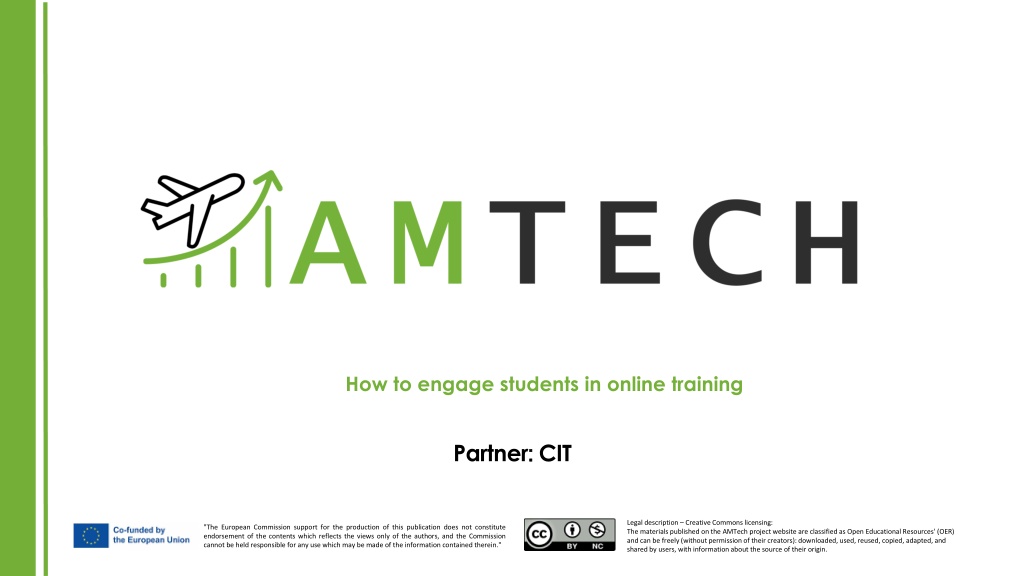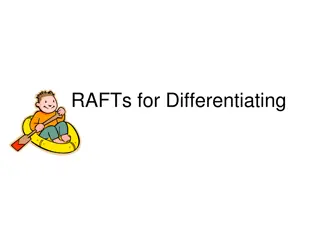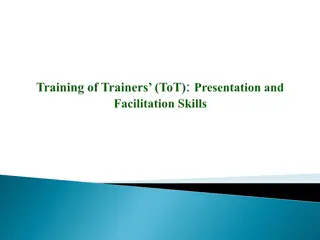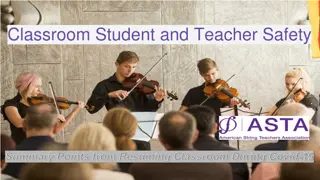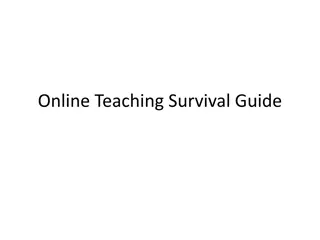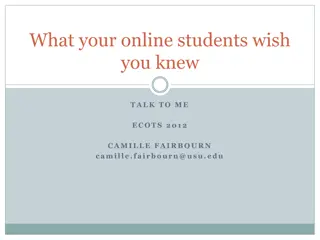Strategies for Engaging Students in Online Training
Understand the importance of student engagement in online training, identify strategies and tips to create an engaging learning environment, utilize technology effectively, address challenges, and monitor student engagement for successful online training delivery.
Download Presentation

Please find below an Image/Link to download the presentation.
The content on the website is provided AS IS for your information and personal use only. It may not be sold, licensed, or shared on other websites without obtaining consent from the author. Download presentation by click this link. If you encounter any issues during the download, it is possible that the publisher has removed the file from their server.
E N D
Presentation Transcript
How to engage students in online training Partner: : CIT Legal description Creative Commons licensing: The materials published on the AMTech project website are classified as Open Educational Resources' (OER) and can be freely (without permission of their creators): downloaded, used, reused, copied, adapted, and shared by users, with information about the source of their origin. "The European Commission support for the production of this publication does not constitute endorsement of the contents which reflects the views only of the authors, and the Commission cannot be held responsible for any use which may be made of the information contained therein."
Objectives & Goals At the end of this module you will be able to: Overview Understand the importance of student engagement in online training. - New strategies Identify strategies to create an engaging online learning environment - New tips Discover tips for promoting active learning - Understand the role of technology in student engagement insisting on the effective use of technology tools and platforms to promote student engagement in online training ICT role - Imagen de ArthurHidden en Freepik Challanges Address challenges/concerns and solutions for online student engagement. - Monitor, evaluate and assess student engagement in online training, - Monitoring Legal description Creative Commons licensing: The materials published on the AMTech project website are classified as Open Educational Resources' (OER) and can be freely (without permission of their creators): downloaded, used, reused, copied, adapted, and shared by users, with information about the source of their origin. "The European Commission support for the production of this publication does not constitute endorsement of the contents which reflects the views only of the authors, and the Commission cannot be held responsible for any use which may be made of the information contained therein."
Index Unit 1: Engaging and Interacting with Users in online training Section 1.1: Strategies for engaging users with digital content in online training Section 1.2: Monitoring user engagement and collecting feedback Section 1.3: Responding to user comments and addressing concerns Unit 2: Analyzing and Improving Online Training Delivery Section 2.1: Metrics and analytics for measuring the success of online training delivery Legal description Creative Commons licensing: The materials published on the AMTech project website are classified as Open Educational Resources' (OER) and can be freely (without permission of their creators): downloaded, used, reused, copied, adapted, and shared by users, with information about the source of their origin. "The European Commission support for the production of this publication does not constitute endorsement of the contents which reflects the views only of the authors, and the Commission cannot be held responsible for any use which may be made of the information contained therein."
1. Unit 1: Engaging and Interacting with Users in online training Section 1.1: Strategies for engaging users with digital content in online training There are various easy and effective strategies for engaging users with digital content in online training, such as: Interactive Content: One of the greatest challenges with online training is keeping learners engaged. In this sense it is fundamental to incorporate interactive elements into your trainings. Interactive elements can take many forms, such quizzes, polls, surveys, and interactive simulations that allow learners to actively participate in the learning process. Interactive items can help students to learn in a fun way and remember information better. A quiz after a training module can help remember it better, and a game simulating a real-life situation can help students use what they have learned. Incorporate interactive elements encourages participation, promotes active learning, and provides immediate feedback, enhancing the overall learning experience. Image source: Freepik.com Legal description Creative Commons licensing: The materials published on the AMTech project website are classified as Open Educational Resources' (OER) and can be freely (without permission of their creators): downloaded, used, reused, copied, adapted, and shared by users, with information about the source of their origin. "The European Commission support for the production of this publication does not constitute endorsement of the contents which reflects the views only of the authors, and the Commission cannot be held responsible for any use which may be made of the information contained therein."
1. Unit 1: Engaging and Interacting with Users in online training Section 1.1: Strategies for engaging users with digital content in online training Multimedia Integration: Text-based online training courses can quickly become boring and unengaging. In this sense it is extremely important to incorporate multimedia items into your trainings. Multimedia can be represented by images, videos, animations, infographic and audio clips to make the content visually appealing and engaging. Not only does multimedia make the training more interesting and engaging, but it can also help the learner to retain the key concepts better. Multimedia helps break the monotony of text- based content and can effectively convey complex information in a more digestible format. Multimedia items can also create an emotional connection with learners by using images or videos that evoke feelings related to the topic taught. Don t be afraid to use diverse modalities to display course content, including audio, video, images, concept maps, etc. Gamification: Incorporate gamification elements such as leaderboards, badges, challenges, and rewards to make the learning experience more enjoyable and motivating. Gamification adds a competitive element, encourages progress tracking, and provides a sense of achievement, which keeps users engaged and motivated to continue learning. Image source: Freepik.com Legal description Creative Commons licensing: The materials published on the AMTech project website are classified as Open Educational Resources' (OER) and can be freely (without permission of their creators): downloaded, used, reused, copied, adapted, and shared by users, with information about the source of their origin. "The European Commission support for the production of this publication does not constitute endorsement of the contents which reflects the views only of the authors, and the Commission cannot be held responsible for any use which may be made of the information contained therein."
1. Unit 1: Engaging and Interacting with Users in online training Section 1.1: Strategies for engaging users with digital content in online training Personalization and Customization: Personalization is becoming more and more important in online training as it help students to feel more connected to the training itself. By personalizing the learning experience, students are more likely to feel engaged and retain information. Tailor the training content to the specific needs and interests of the users, provide options for users to customize their learning experience, such as choosing the order of modules or selecting topics of relevance have proved to be highly useful to retain students interest. Personalization increases user engagement by making the content more relevant and meaningful to their individual learning goals. Personalization can be represented by the possibility to choose a learning path or the customization of content based on preferences. Personalization can also be achieved by incorporating real-life examples relevant to the learner's specific background. Incorporating personalization help learners to feel more engaged in their learning, leading to better retention rates. Personalization can also help to reduce dropout rates, as learners are more likely to complete a course that is tailored to their needs and interests. Image source: Freepik.com Legal description Creative Commons licensing: The materials published on the AMTech project website are classified as Open Educational Resources' (OER) and can be freely (without permission of their creators): downloaded, used, reused, copied, adapted, and shared by users, with information about the source of their origin. "The European Commission support for the production of this publication does not constitute endorsement of the contents which reflects the views only of the authors, and the Commission cannot be held responsible for any use which may be made of the information contained therein."
1. Unit 1: Engaging and Interacting with Users in online training Section 1.1: Strategies for engaging users with digital content in online training Bite-sized Learning: It is important to break the content into smaller, manageable chunks to facilitate easier consumption. Use short (10 minute) audio and video lectures. Shorter presentations with varied media can optimize student engagement and allow for ease of updating in the future. It always better to deliver the content in short modules or lessons that can be completed within a specific timeframe. This approach helps prevent information overload, improves retention, and accommodates users' limited attention spans. Social Learning and Collaboration: Foster a sense of community and collaboration by incorporating social learning elements, like building a group or a community. There are several great ways to build an online community to more effectively engage with your trainees. Forums are still a widely used method of engaging with students and allowing them to engage with each other. Include discussion forums, group activities, or virtual classrooms where users can interact, share insights, and learn from each other. Bring the conversation to them on their social networks of choice. Facebook Groups and LinkedIn Groups are just example of social networks that allow individuals to interact in communities. Social interaction enhances engagement and provides an opportunity for peer-to-peer learning. Image source: Freepik.com Legal description Creative Commons licensing: The materials published on the AMTech project website are classified as Open Educational Resources' (OER) and can be freely (without permission of their creators): downloaded, used, reused, copied, adapted, and shared by users, with information about the source of their origin. "The European Commission support for the production of this publication does not constitute endorsement of the contents which reflects the views only of the authors, and the Commission cannot be held responsible for any use which may be made of the information contained therein."
1. Unit 1: Engaging and Interacting with Users in online training Section 1.1: Strategies for engaging users with digital content in online training Real-life Scenarios and Case Studies: One of the best strategies to engage students is to incorporate real-life scenarios into your online training, to help them to see how the concepts studied apply to real-world settings. Create attention grabbing content to introduce learning objectives (i.e. media clips, documentaries, case studies) to connect course content to the real world . By using realistic situations, learners are more likely to retain information and apply it in their own lives. Present real-life scenarios and case studies that reflect practical applications of the training content. This helps users understand the relevance of the material and provides opportunities for critical thinking and problem-solving, making the learning experience more engaging and relatable. Mobile-Friendly Design: In today's mobile-ruled world, it is core that your online training is optimized for mobile devices, with a responsive layout that adjusts to different screen sizes and devices, including smartphones and tablets. This ensures full accessibility on the trainee s side and increases the flexibility of training. Mobile-friendly design allows users to engage with the content anytime, anywhere, increasing it easiness and convenience. Mobile-friendly online training can also include features that are specific to mobile devices, such as the ability to swipe or tap to navigate, or use voice-activated interactions. Designing courses with a mobile approach can improve the overall User Experience, as it simplifies contents and focuses on the most important information. Image source: Freepik.com Legal description Creative Commons licensing: The materials published on the AMTech project website are classified as Open Educational Resources' (OER) and can be freely (without permission of their creators): downloaded, used, reused, copied, adapted, and shared by users, with information about the source of their origin. "The European Commission support for the production of this publication does not constitute endorsement of the contents which reflects the views only of the authors, and the Commission cannot be held responsible for any use which may be made of the information contained therein."
1. Unit 1: Engaging and Interacting with Users in online training Section 1.1: Strategies for engaging users with digital content in online training Continuous Learning Opportunities: It is important to offer ongoing learning resources and opportunities beyond the initial training. Provide additional materials, recommended readings, or access to relevant webinars or workshops can increase students engagement and motivates their further learning. Encouraging continuous learning helps maintain user engagement and supports long-term knowledge retention. Webinars: Another innovative and effective way of engaging with your students is organizing webinars that are user-friendly and interactive. People love the live video of the presenter, slides, graphics, and other interactive options of webinars. This strategy allows the teacher to make a very personal connection with students and the speaker of the webinar can be more passionate, entertaining, and engaging than just reading through an online text. It is also interesting to ask students to participate allowing them to pose comments or questions to the teacher via chat or email to increase the engagement and interaction. This interaction also allows you to make use of co-creation engagement strategies, where your online training is really made thanks to students interaction and therefore it is much more engaging! Co-creation helps developing a much stronger bond, students feel proud as they became part of the training process and in this sense, it is important to reward their ideas, recognizing their contribution in the process. Image source: Freepik.com Legal description Creative Commons licensing: The materials published on the AMTech project website are classified as Open Educational Resources' (OER) and can be freely (without permission of their creators): downloaded, used, reused, copied, adapted, and shared by users, with information about the source of their origin. "The European Commission support for the production of this publication does not constitute endorsement of the contents which reflects the views only of the authors, and the Commission cannot be held responsible for any use which may be made of the information contained therein."
1. Unit 1: Engaging and Interacting with Users in online training Section 1.1: Strategies for engaging users with digital content in online training By incorporating these strategies, online training can be made more engaging, interactive, and effective in capturing users' attention, promoting active participation, and enhancing the overall learning experience. Finding the right engagement strategy takes time, ICT offers many great ways to interact and engage with students online. Take advantage of all the free tools and resources available, test them in your training online and devise a plan to better engage and interact with your trainees for a successful learning experience! Image source: Freepik.com Legal description Creative Commons licensing: The materials published on the AMTech project website are classified as Open Educational Resources' (OER) and can be freely (without permission of their creators): downloaded, used, reused, copied, adapted, and shared by users, with information about the source of their origin. "The European Commission support for the production of this publication does not constitute endorsement of the contents which reflects the views only of the authors, and the Commission cannot be held responsible for any use which may be made of the information contained therein."
1. Unit 1: Engaging and Interacting with Users in online training Section 1.2: Monitoring user engagement and collecting feedback Monitoring user engagement and collecting feedback are two vital tasks to ensure an effective online training. There are some actions that we can take before the lesson begins, such as making sure students have the basic skills needed to understand your training contents. Make sure your terminology is suitable for students knowledge and give them time to properly retain concepts. Once students enter the online training area, they should feel in the right place and you should create a welcoming experience to help them notwithstanding their background. It is important to take into consideration non-verbal signals that you might gather from your audience, and in this sense, it is fundamental to ask students to maintain their camera on, so that you can monitor their engagement. Image source: Freepik.com Legal description Creative Commons licensing: The materials published on the AMTech project website are classified as Open Educational Resources' (OER) and can be freely (without permission of their creators): downloaded, used, reused, copied, adapted, and shared by users, with information about the source of their origin. "The European Commission support for the production of this publication does not constitute endorsement of the contents which reflects the views only of the authors, and the Commission cannot be held responsible for any use which may be made of the information contained therein."
1. Unit 1: Engaging and Interacting with Users in online training Section 1.2: Monitoring user engagement and collecting feedback It is always interesting to start online training with a quick introduction of the trainer, including hobbies, family, pets to make a human connection and if possible, give the possibility to trainees to introduce themselves in order to build up a community of training. Use an icebreaking activity to get students to introduce themselves (e.g. introductory discussion, create a PowerPoint slide about themselves). During the lesson you should encourage students to participate in class and get feedback instantly by using ICT tools and polls, such as Padlet to allow trainees to share their insights while training and communicate with each another. Regularly take the temperature and try to grasp feedback from the audience to monitor their engagement. Image source: Freepik.com Legal description Creative Commons licensing: The materials published on the AMTech project website are classified as Open Educational Resources' (OER) and can be freely (without permission of their creators): downloaded, used, reused, copied, adapted, and shared by users, with information about the source of their origin. "The European Commission support for the production of this publication does not constitute endorsement of the contents which reflects the views only of the authors, and the Commission cannot be held responsible for any use which may be made of the information contained therein."
1. Unit 1: Engaging and Interacting with Users in online training Section 1.2: Monitoring user engagement and collecting feedback Once the class has finished, it is important to use online programs to reinforce skills learned and apply them to real-life settings. Ask what were the topics that your students found most difficult and offer additional support to those who need it. In online training it is extremely important to implement progress tracking features that allow users to monitor progress and receive feedback on their performance. Feedback is an essential feature in online learning. That is why it is important to provide students with feedback mechanisms in their training, such as quizzes, tests, and other activities to gauge their proficiency. Clear feedback and progress indicators motivate users and provide a sense of accomplishment as they see their advancement through the training. And if results are presented, celebrate together, as their success is your success! Image source: Freepik.com Legal description Creative Commons licensing: The materials published on the AMTech project website are classified as Open Educational Resources' (OER) and can be freely (without permission of their creators): downloaded, used, reused, copied, adapted, and shared by users, with information about the source of their origin. "The European Commission support for the production of this publication does not constitute endorsement of the contents which reflects the views only of the authors, and the Commission cannot be held responsible for any use which may be made of the information contained therein."
1. Unit 1: Engaging and Interacting with Users in online training Section 1.2: Monitoring user engagement and collecting feedback Part of successfully engaging with your students is being sure to take the time and listen to them. It is not enough to just train them; you need to show that you value their thoughts and that there is an interaction among real people in real life. Make sure that you respond to both positive and negative feedback. Feedback is particularly useful also for future customization of your training to make sure that it really responds to trainees needs. Feedback can be cognitive (related to the information about how students learn and understand the training material), behavioral (information on how students behave in their classes, like going to class regularly and completing their homework) or social (how students talk and work with others in their class, joining in online conversations and working together on projects). Finally, in case needed, trainer interventions should be light to make sure the student can recover their training path at their pace, ensuring their autonomy, avoiding demotivation. Image source: Freepik.com Legal description Creative Commons licensing: The materials published on the AMTech project website are classified as Open Educational Resources' (OER) and can be freely (without permission of their creators): downloaded, used, reused, copied, adapted, and shared by users, with information about the source of their origin. "The European Commission support for the production of this publication does not constitute endorsement of the contents which reflects the views only of the authors, and the Commission cannot be held responsible for any use which may be made of the information contained therein."
1. Unit 1: Engaging and Interacting with Users in online training Section 1.3: Responding to user comments and addressing concerns Responding to user comments and addressing their concerns in online training is essential for fostering a positive learning environment and maintaining learner engagement. Here are some guidelines for effectively responding to user comments and addressing their concerns: Prompt Response: Aim to respond to user comments and concerns in a timely manner. Prompt responses show that you value their input and are committed to addressing their needs. Ideally, strive to reply within 24-48 hours, depending on the urgency of the matter. Be present in your course, show presence multiple times/week. Active Listening: Read user comments attentively to fully understand their concerns. Take the time to comprehend their perspective and the underlying issue they are expressing. Avoid making assumptions or jumping to conclusions before fully grasping the context. Image source: Freepik.com Legal description Creative Commons licensing: The materials published on the AMTech project website are classified as Open Educational Resources' (OER) and can be freely (without permission of their creators): downloaded, used, reused, copied, adapted, and shared by users, with information about the source of their origin. "The European Commission support for the production of this publication does not constitute endorsement of the contents which reflects the views only of the authors, and the Commission cannot be held responsible for any use which may be made of the information contained therein."
1. Unit 1: Engaging and Interacting with Users in online training Section 1.3: Responding to user comments and addressing concerns Respectful and Empathetic Tone: Respond to user comments in a respectful and empathetic manner. Use a polite and understanding tone to acknowledge their concerns. Empathy helps to build rapport and demonstrates your commitment to supporting their learning experience. Address Concerns Directly: Respond directly to the concerns raised by users. Provide relevant information, solutions, or explanations to address their issues. Be specific and concise in your response, focusing on actionable steps or clarifications. Offer Solutions: Whenever possible, propose viable solutions to address user concerns. Provide clear instructions or suggestions to help users overcome any challenges they may be facing. Offer additional resources, guidance, or alternative approaches that can assist them in their learning journey. Image source: Freepik.com Legal description Creative Commons licensing: The materials published on the AMTech project website are classified as Open Educational Resources' (OER) and can be freely (without permission of their creators): downloaded, used, reused, copied, adapted, and shared by users, with information about the source of their origin. "The European Commission support for the production of this publication does not constitute endorsement of the contents which reflects the views only of the authors, and the Commission cannot be held responsible for any use which may be made of the information contained therein."
1. Unit 1: Engaging and Interacting with Users in online training Section 1.3: Responding to user comments and addressing concerns Personalize Responses: Whenever feasible, personalize your responses to make users feel valued and heard. Address them by their name, refer to specific points they raised, and tailor your response to their unique situation. Personalization helps create a more meaningful connection with users. Encourage Further Communication: Encourage users to continue the conversation if they have further questions or require additional assistance. Provide contact information, such as an email address or a support forum, where they can reach out for further guidance. Let them know that their feedback is valued and that you are there to help. Constructive Feedback: If users express criticism or suggestions for improvement, respond with gratitude and an open mindset. Acknowledge their feedback and let them know that their input is valuable for enhancing the training experience. Thank them for their suggestions and assure them that you will consider their input for future updates or improvements. Image source: Freepik.com Legal description Creative Commons licensing: The materials published on the AMTech project website are classified as Open Educational Resources' (OER) and can be freely (without permission of their creators): downloaded, used, reused, copied, adapted, and shared by users, with information about the source of their origin. "The European Commission support for the production of this publication does not constitute endorsement of the contents which reflects the views only of the authors, and the Commission cannot be held responsible for any use which may be made of the information contained therein."
2. Unit 2: Analyzing and Improving Online Training Delivery Section 2.1: Metrics and analytics for measuring the success of online training delivery Measuring the success of online training delivery requires the use of relevant metrics and analytics to assess various aspects of the training program. Here are some key metrics and analytics that can help measure the effectiveness and impact of online training delivery: Completion Rates: Measure the percentage of learners who successfully complete the online training program. This metric indicates the overall engagement and commitment of learners to complete the training. Participation Rates: Track the level of participation and engagement throughout the training program. Measure metrics such as the number of logins, time spent on the platform, and activities completed. This provides insights into the level of learner engagement and interaction with the training content. Image source: Freepik.com Legal description Creative Commons licensing: The materials published on the AMTech project website are classified as Open Educational Resources' (OER) and can be freely (without permission of their creators): downloaded, used, reused, copied, adapted, and shared by users, with information about the source of their origin. "The European Commission support for the production of this publication does not constitute endorsement of the contents which reflects the views only of the authors, and the Commission cannot be held responsible for any use which may be made of the information contained therein."
2. Unit 2: Analyzing and Improving Online Training Delivery Section 2.1: Metrics and analytics for measuring the success of online training delivery Assessment Performance: Analyze the performance of learners in assessments, quizzes, or knowledge checks. Measure metrics such as average scores, pass rates, and improvement over time. This helps evaluate the effectiveness of the training content and the extent to which learners have acquired the intended knowledge or skills. Learner Satisfaction: Gather feedback from learners through surveys or feedback forms to measure their satisfaction with the online training program. Assess their perceptions of the training content, delivery methods, user experience, and overall effectiveness. This provides insights into the quality of the training and areas for improvement. Image source: Freepik.com Legal description Creative Commons licensing: The materials published on the AMTech project website are classified as Open Educational Resources' (OER) and can be freely (without permission of their creators): downloaded, used, reused, copied, adapted, and shared by users, with information about the source of their origin. "The European Commission support for the production of this publication does not constitute endorsement of the contents which reflects the views only of the authors, and the Commission cannot be held responsible for any use which may be made of the information contained therein."
2. Unit 2: Analyzing and Improving Online Training Delivery Section 2.1: Metrics and analytics for measuring the success of online training delivery Knowledge Application: Assess the ability of learners to apply the acquired knowledge or skills in real-life situations. This can be done through practical assessments, case studies, or performance evaluations. Measure the extent to which learners can effectively transfer their learning to practical scenarios. Peer Engagement: Analyze the level of interaction and collaboration among learners. Measure metrics such as discussion forum participation, peer-to-peer feedback, or collaborative project completion. This indicates the effectiveness of the online training environment in fostering peer learning and knowledge sharing. Image source: Freepik.com Legal description Creative Commons licensing: The materials published on the AMTech project website are classified as Open Educational Resources' (OER) and can be freely (without permission of their creators): downloaded, used, reused, copied, adapted, and shared by users, with information about the source of their origin. "The European Commission support for the production of this publication does not constitute endorsement of the contents which reflects the views only of the authors, and the Commission cannot be held responsible for any use which may be made of the information contained therein."
2. Unit 2: Analyzing and Improving Online Training Delivery Section 2.1: Metrics and analytics for measuring the success of online training delivery Learning Analytics: Utilize learning analytics platforms or tools to track learner behavior, engagement patterns, and performance data. Analyze data such as click-through rates, time on task, resource utilization, or social interactions. This provides deeper insights into learner preferences, challenges, and opportunities for improvement. Business Impact: Assess the business impact of the online training program by measuring relevant metrics tied to organizational goals. For example, measure improvements in performance, productivity, satisfaction, or key performance indicators (KPIs) relevant to the training objectives. This helps demonstrate the tangible value and return on investment (ROI) of the training program. Measuring online training metrics is a must when you want to ensure your online learning experience is useful. With each piece of data, you have a golden opportunity to make adjustments. Image source: Freepik.com Legal description Creative Commons licensing: The materials published on the AMTech project website are classified as Open Educational Resources' (OER) and can be freely (without permission of their creators): downloaded, used, reused, copied, adapted, and shared by users, with information about the source of their origin. "The European Commission support for the production of this publication does not constitute endorsement of the contents which reflects the views only of the authors, and the Commission cannot be held responsible for any use which may be made of the information contained therein."
Summing up To engage students in online training It is important to customized contents and add interactive resources Monitoring user engagement Is vital for effective online training Social Learning and Collaboration Analyzing training metrics Can help improve training contents and users engagement Foster a sense of community and enhances engagement Image source: Flaticon.com Legal description Creative Commons licensing: The materials published on the AMTech project website are classified as Open Educational Resources' (OER) and can be freely (without permission of their creators): downloaded, used, reused, copied, adapted, and shared by users, with information about the source of their origin. "The European Commission support for the production of this publication does not constitute endorsement of the contents which reflects the views only of the authors, and the Commission cannot be held responsible for any use which may be made of the information contained therein."
Thank you! you! Legal description Creative Commons licensing: The materials published on the AMTech project website are classified as Open Educational Resources' (OER) and can be freely (without permission of their creators): downloaded, used, reused, copied, adapted, and shared by users, with information about the source of their origin. "The European Commission support for the production of this publication does not constitute endorsement of the contents which reflects the views only of the authors, and the Commission cannot be held responsible for any use which may be made of the information contained therein."
